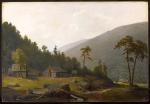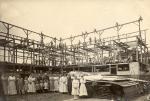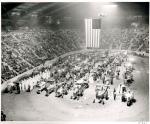Chapter Two: The Pennsylvania Farm
After receiving his charter from King Charles II for land in America, William Penn envisioned Pennsylvania as a colony that would re-create the old English village system. Each village, centrally located in a 5,000-acre township, would consist of about ten families who would farm the surrounding land.
Penn's plan immediately ran into difficulties. His grant included parts of what had once been the Swedish colony of New Sweden and the Dutch colony of New Netherlands, whose Dutch, Finnish, and Swedish settlers already lived on farms scattered along the creeks and rivers that flowed into the Delaware River and Bay. And he quickly found out that the English, Welsh, Irish, German,
New Sweden and the Dutch colony of New Netherlands, whose Dutch, Finnish, and Swedish settlers already lived on farms scattered along the creeks and rivers that flowed into the Delaware River and Bay. And he quickly found out that the English, Welsh, Irish, German,  Swiss Amish, and Scots-Irish settlers who came after he took possession of the region were an independent-minded lot, who had no compelling reason to re-create old English villages. Instead, they bought or occupied plots of land ranging from 100 to 300 acres upon which they established their own farms. Thus, small farms scattered across the landscape became the primary pattern of settlement in Pennsylvania.
Swiss Amish, and Scots-Irish settlers who came after he took possession of the region were an independent-minded lot, who had no compelling reason to re-create old English villages. Instead, they bought or occupied plots of land ranging from 100 to 300 acres upon which they established their own farms. Thus, small farms scattered across the landscape became the primary pattern of settlement in Pennsylvania.
This dispersed settlement thwarted Penn's plans, but it was good for his colony's economic growth and development. Many middle and lower class immigrants came to the colony specifically for the chance to become farmers on their own property and many achieved this goal. On the fertile, well-watered lands of southeast Pennsylvania, colonists carved out family farms that they divided into pasture, woodland, and farm fields.
Typical of these early settlers was Thomas Massey, a young Englishman who came to Pennsylvania as an indentured servant in 1683. After working off his indenture in Philadelphia, Massey received land in Chester County, as part of the settlement of his contract. He worked hard, cleared and farmed his land, built a cabin and then a fine brick addition, and raised a family. Arriving in Pennsylvania with little more than the clothes on his back, Massey became an independent and prosperous farmer.
Thomas Massey, a young Englishman who came to Pennsylvania as an indentured servant in 1683. After working off his indenture in Philadelphia, Massey received land in Chester County, as part of the settlement of his contract. He worked hard, cleared and farmed his land, built a cabin and then a fine brick addition, and raised a family. Arriving in Pennsylvania with little more than the clothes on his back, Massey became an independent and prosperous farmer.
By the mid-1700s, the greater Delaware Valley region and southern Susquehanna Valley were the breadbasket of colonial America, the largest exporter of flour and wheat in the British colonies. To prepare wheat and corn for consumption, they had to be milled into flour and meal. Milling became the first major industry in Pennsylvania. For centuries, water-powered gristmills, like Cumberland County's Laughlin Mill and Chester County's
Laughlin Mill and Chester County's  Mill at Anselma –the nation's best surviving example of a water-powered custom grist mill –were bustling centers of activity in communities across the Commonwealth, producing both animal feed and flour for farmers, merchants in nearby cities and towns, and people all across the Atlantic world.
Mill at Anselma –the nation's best surviving example of a water-powered custom grist mill –were bustling centers of activity in communities across the Commonwealth, producing both animal feed and flour for farmers, merchants in nearby cities and towns, and people all across the Atlantic world.
After America gained independence, the Commonwealth's agricultural economy entered its golden age, and the neat and prosperous Pennsylvania farm became the model for farms across the nation. During this period the Pennsylvania barn emerged as one of the state's most distinctive architectural features and a symbol of the agricultural prosperity. The Pennsylvania farm also became important subject matter for Quaker artist Edward Hicks, today renowned for his paintings of the "Peaceable Kingdom," an idealized world that expressed Hicks's religious convictions about the peaceful coexistence of man with nature.
Edward Hicks, today renowned for his paintings of the "Peaceable Kingdom," an idealized world that expressed Hicks's religious convictions about the peaceful coexistence of man with nature.
Pennsylvania agriculture during this time was extraordinary in its diversity. Farming was a collaborative operation in which families and neighbors worked together, and in which butter and cheese made by women became one of the Pennsylvania farm's most important income generating products.
butter and cheese made by women became one of the Pennsylvania farm's most important income generating products.
Increasing and improving farm production became a goal of agricultural reformers in the late eighteenth century. In the 1790s John Beale Bordley established one of the first model farms in the country on his "Como Farms" estate in Chester County. In 1857 agricultural reformer
John Beale Bordley established one of the first model farms in the country on his "Como Farms" estate in Chester County. In 1857 agricultural reformer  Frederick Watts, who had earlier helped found the Pennsylvania Agricultural Society to bring modern science to the aid of farmers, developed a model "progressive" farm on a 116-acre tract near Carlisle. There he built a house and large multi-functional barn, both of which he designed for maximum convenience and efficiency. Championing changes that were often impractical or uneconomical these agricultural reformers had limited influence, but they helped lay the groundwork for the significant changes that would come later.
Frederick Watts, who had earlier helped found the Pennsylvania Agricultural Society to bring modern science to the aid of farmers, developed a model "progressive" farm on a 116-acre tract near Carlisle. There he built a house and large multi-functional barn, both of which he designed for maximum convenience and efficiency. Championing changes that were often impractical or uneconomical these agricultural reformers had limited influence, but they helped lay the groundwork for the significant changes that would come later.
By the 1850s canals, paved roads, and railroads were drawing a growing number of Pennsylvania farmers into the nation's emerging market economy. To increase their production and reduce their work, a new generation of business-minded farmers utilized new forms of horse and water-powered machinery. In Chester County, the Dickey brothers used water wheels they constructed on the Hopewell Creek to irrigate their hillside fields and to power spinning mills, iron foundries, and other industrial enterprises. They also built a rural community today preserved as the Hopewell Historic District.
Hopewell Historic District.
Soon after their arrival in Pennsylvania, colonists began to hold fairs, as they had in the Old World, to socialize and exchange ideas, display and sell their handicrafts, conduct business, and discuss common concerns. Farm fairs spread with settlement. Tracing its origins back to 1765, the York Inter-State Fair is among the oldest in the nation and has been held annually since 1853. First held in 1917, the
York Inter-State Fair is among the oldest in the nation and has been held annually since 1853. First held in 1917, the  Pennsylvania Farm Show celebrates agriculture in the Commonwealth and today is the nation's single largest indoor agricultural event.
Pennsylvania Farm Show celebrates agriculture in the Commonwealth and today is the nation's single largest indoor agricultural event.
Throughout the 1800s, American farmers were a mobile people, constantly in search of new, more fertile lands on the moving frontier. In the early decades of the century, western settlement became a race between the free soil farmers of the North and southern planters who depended upon African-American slave labor. In the 1840s and 1850s, northern congressmen attempted repeatedly to pass legislation to open the nation's western territories to farmers. After the outbreak of the Civil War, the southern opponents to such an act were removed from Washington. In 1862, Congress passed the Homestead Act, legislation championed by Pennsylvania Congressman and the Speaker of the House of Representatives
Homestead Act, legislation championed by Pennsylvania Congressman and the Speaker of the House of Representatives  Galusha Grow. To Grow and other supporters of the Homestead Act, the Pennsylvania farm served as an important model for the settlement of the American West.
Galusha Grow. To Grow and other supporters of the Homestead Act, the Pennsylvania farm served as an important model for the settlement of the American West.
The family-owned farm was an important symbol to nineteenth-century Americans, but even in the Commonwealth, farm tenancy was common. The late 1800s were a period of prolonged hardship for American and Commonwealth farmers as the newly opened West flooded eastern markets with grain and meat. By the early 1900s, more than one-quarter of all Pennsylvania farms were operated by tenants, most working on the sharecrop system. In Cumberland County, tenants operated at least 40 percent of the farms.
Cumberland County, tenants operated at least 40 percent of the farms.
The Industrial Revolution unleashed market forces that made it increasingly difficult for many American family farmers to stay in business. The vision of the United States as a land of prosperous and independent family farmers collapsed in the twentieth century as global market forces, mechanization, and capital-intensive agribusinesses drove many small family farms under.
In the twentieth century, the number of farms in Pennsylvania plunged from 225,000 to 59,000. Farm life, too, became less attractive, as the children of farm families sought their fortunes in the cities and towns. To meet their labor needs, Pennsylvania farmers in Potter County and elsewhere turned to migrant laborers from the American South, the Caribbean, and Latin America.
Potter County and elsewhere turned to migrant laborers from the American South, the Caribbean, and Latin America.
As their numbers diminished, small Pennsylvania farms became a cherished part of the state's history. In the early 1900s, the Landis brothers of Lancaster County began to collect tools, domestic items, and the handicrafts of a rapidly disappearing rural world. Deeded to the Commonwealth in 1953, the Landis Brothers" Landis Valley Museum houses a rare collection of artifacts and outbuildings that document the history of the Pennsylvania farm from the colonial era into the twentieth century.
Landis Valley Museum houses a rare collection of artifacts and outbuildings that document the history of the Pennsylvania farm from the colonial era into the twentieth century.
Penn's plan immediately ran into difficulties. His grant included parts of what had once been the Swedish colony of
This dispersed settlement thwarted Penn's plans, but it was good for his colony's economic growth and development. Many middle and lower class immigrants came to the colony specifically for the chance to become farmers on their own property and many achieved this goal. On the fertile, well-watered lands of southeast Pennsylvania, colonists carved out family farms that they divided into pasture, woodland, and farm fields.
Typical of these early settlers was
By the mid-1700s, the greater Delaware Valley region and southern Susquehanna Valley were the breadbasket of colonial America, the largest exporter of flour and wheat in the British colonies. To prepare wheat and corn for consumption, they had to be milled into flour and meal. Milling became the first major industry in Pennsylvania. For centuries, water-powered gristmills, like Cumberland County's
After America gained independence, the Commonwealth's agricultural economy entered its golden age, and the neat and prosperous Pennsylvania farm became the model for farms across the nation. During this period the Pennsylvania barn emerged as one of the state's most distinctive architectural features and a symbol of the agricultural prosperity. The Pennsylvania farm also became important subject matter for Quaker artist
Pennsylvania agriculture during this time was extraordinary in its diversity. Farming was a collaborative operation in which families and neighbors worked together, and in which
Increasing and improving farm production became a goal of agricultural reformers in the late eighteenth century. In the 1790s
By the 1850s canals, paved roads, and railroads were drawing a growing number of Pennsylvania farmers into the nation's emerging market economy. To increase their production and reduce their work, a new generation of business-minded farmers utilized new forms of horse and water-powered machinery. In Chester County, the Dickey brothers used water wheels they constructed on the Hopewell Creek to irrigate their hillside fields and to power spinning mills, iron foundries, and other industrial enterprises. They also built a rural community today preserved as the
Soon after their arrival in Pennsylvania, colonists began to hold fairs, as they had in the Old World, to socialize and exchange ideas, display and sell their handicrafts, conduct business, and discuss common concerns. Farm fairs spread with settlement. Tracing its origins back to 1765, the
Throughout the 1800s, American farmers were a mobile people, constantly in search of new, more fertile lands on the moving frontier. In the early decades of the century, western settlement became a race between the free soil farmers of the North and southern planters who depended upon African-American slave labor. In the 1840s and 1850s, northern congressmen attempted repeatedly to pass legislation to open the nation's western territories to farmers. After the outbreak of the Civil War, the southern opponents to such an act were removed from Washington. In 1862, Congress passed the
The family-owned farm was an important symbol to nineteenth-century Americans, but even in the Commonwealth, farm tenancy was common. The late 1800s were a period of prolonged hardship for American and Commonwealth farmers as the newly opened West flooded eastern markets with grain and meat. By the early 1900s, more than one-quarter of all Pennsylvania farms were operated by tenants, most working on the sharecrop system. In
The Industrial Revolution unleashed market forces that made it increasingly difficult for many American family farmers to stay in business. The vision of the United States as a land of prosperous and independent family farmers collapsed in the twentieth century as global market forces, mechanization, and capital-intensive agribusinesses drove many small family farms under.
In the twentieth century, the number of farms in Pennsylvania plunged from 225,000 to 59,000. Farm life, too, became less attractive, as the children of farm families sought their fortunes in the cities and towns. To meet their labor needs, Pennsylvania farmers in
As their numbers diminished, small Pennsylvania farms became a cherished part of the state's history. In the early 1900s, the Landis brothers of Lancaster County began to collect tools, domestic items, and the handicrafts of a rapidly disappearing rural world. Deeded to the Commonwealth in 1953, the Landis Brothers"














